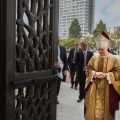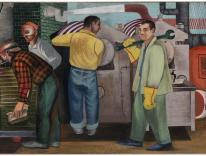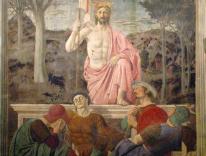After the day-long media storm over news that San Francisco’s Saint Mary’s Cathedral had for two years been using a watering system to douse homeless people sheltering in its alcoves, the archdiocese has issued an apology and states that the system has been removed.
(Update: Bishop William Justice, who is also the auxiliary bishop of the archdiocese, addresses the press in this video clip. "Nobody mentioned anything for two years," he says at one point. "Not that that makes it right.")
 The cathedral, the home church of Archbishop Salvatore Cordileone, installed the system about two years ago after learning about its effectiveness in the city’s financial district “as a safety, security and cleanliness measure.” The sprinklers, mounted about thirty feet high in four locations, would activate automatically every thirty to sixty minutes, for more than a minute, simultaneously in all locations. There were no signs to warn those gathered below that such a system was in use, though according to archdiocese spokesperson Larry Kramer, “No Trespassing” signs had been posted.
The cathedral, the home church of Archbishop Salvatore Cordileone, installed the system about two years ago after learning about its effectiveness in the city’s financial district “as a safety, security and cleanliness measure.” The sprinklers, mounted about thirty feet high in four locations, would activate automatically every thirty to sixty minutes, for more than a minute, simultaneously in all locations. There were no signs to warn those gathered below that such a system was in use, though according to archdiocese spokesperson Larry Kramer, “No Trespassing” signs had been posted.
At the time of installation, the cathedral felt it was “fighting a losing battle against crack pipes and condoms and human waste,” Kramer said. The cathedral had tried extra lighting and security guards, without success, according to Kramer, who acknowledged there was “hesitation” about other methods – including gates to close off the areas in question. When asked whether the cathedral would have continued its practice of dousing homeless people if not for Wednesday’s report by a local radio station, Kramer allowed that that was a “fair” assumption. The method “worked,” he said, though it is unclear how well, given that homeless people were still sheltering in these areas, in some cases using umbrellas.
Though the archdiocese says it tried to get homeless people to move to other areas at the cathedral, it has not specifically identified those locations. Further, the system, according to reports, did not in fact clean the alcove areas: because no drainage system was installed, water would simply collect where it fell. The cathedral also installed the system without acquiring necessary city permits; it may also violate water-use laws in California, which is in its fourth year of damaging drought. Asked why or how the cathedral could have undertaken installation of a system of such scope in such a prominent structure, without permits, Kramer said the “why when and how of the original decision remains fuzzy.” He said that the cathedral – “normally assiduous” about process -- had acquired retroactive permitting for the original installation as it prepared to dismantle the system yesterday.
There’s more than what publicity people call “unfortunate optics” here. That a Catholic church could treat vulnerable people gathered on its own steps with such disregard is bad enough on its own, but there’s something additionally troubling about it being expressed so, well, cowardly -- from above, without warning, and automatically activated: set it, and forget it. Think about how those who approved the system and countenanced its continued operation might not have been all that far away, perhaps sleeping, and almost certainly dry.
But, said Kramer: “As human beings, they felt terrible.”
There may yet be more to come on this.
Please email comments to [email protected] and join the conversation on our Facebook page.
Share
Previous Story
The High Cost of Netanyahu's Comeback
Next Story
True Worship


